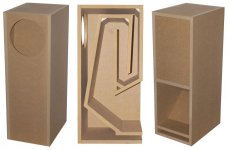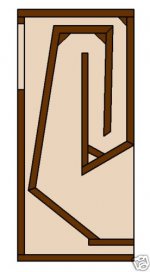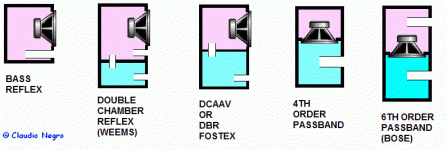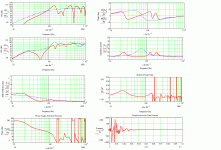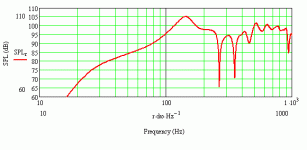Hi!
I'm just woundering about the internal layout of the legendary Lowther Classic 200 enclosure design. Would anyone please explain me what's going on inside this, in my eyes very special, design?
It seems that the rear loaded horn compression chamber is vented thru a duct into another chamber, which is then ported to the outside at the bottom of the horn mouth....? Or am I completely wrong?
But what's the advantage to combine such a DCAAV/DBR design with an rear loaded horn?
Anyone experienced with something like this?
Would it be possible to combine this principle with an front loaded horn as well?
Thanks in advance!
greez
I'm just woundering about the internal layout of the legendary Lowther Classic 200 enclosure design. Would anyone please explain me what's going on inside this, in my eyes very special, design?
It seems that the rear loaded horn compression chamber is vented thru a duct into another chamber, which is then ported to the outside at the bottom of the horn mouth....? Or am I completely wrong?
But what's the advantage to combine such a DCAAV/DBR design with an rear loaded horn?
Anyone experienced with something like this?
Would it be possible to combine this principle with an front loaded horn as well?
Thanks in advance!
greez
Attachments
Give people a chance. Not everyone has sufficient time in the day to provide instant answers.
I don't know about 'legendary.' 'Modestly-well-known-in-Lowther-circles' perhaps. That particular cabinet is actually called the Bicor 200.
Anyway, FYI, short of the miniscule handful of reactance annulled designs, back-horns don't actually possess compression chambers per se; it's a low-pass filter chamber. Regarding what Lowther are up to with their Bicor cabinets, they're presumably employing a tuned Helmholtz cavity / resonator to fill in a harmonic null; probably F3 or F5. Fostex do the same in the (sadly, IMO rubbish) free plan they supply for their FE126E[n]: http://www.fostexinternational.com/docs/speaker_components/pdf/recom_enclose/fe126e_encl.pdf Hopefully the Bicor cabinets are better, although I haven't heard many especially enthusiastic comments. Then again, I suspect the majority of Lowther owners never go near forums and remain largely in the background, so that doesn't necessarily mean anything.
For a front horn? As in venting the compression-chamber? No big deal there. Eminence & others have done that in some of their pro-audio LF enclosures for decades & the DSL style double-tapped horn is essentially this idea taken to its logical extreme. A different variation (for different purposes) is seen in various Altec VOTT designs like the A7, which is essentially a BR with a front-horn attached.
I don't know about 'legendary.' 'Modestly-well-known-in-Lowther-circles' perhaps. That particular cabinet is actually called the Bicor 200.
Anyway, FYI, short of the miniscule handful of reactance annulled designs, back-horns don't actually possess compression chambers per se; it's a low-pass filter chamber. Regarding what Lowther are up to with their Bicor cabinets, they're presumably employing a tuned Helmholtz cavity / resonator to fill in a harmonic null; probably F3 or F5. Fostex do the same in the (sadly, IMO rubbish) free plan they supply for their FE126E[n]: http://www.fostexinternational.com/docs/speaker_components/pdf/recom_enclose/fe126e_encl.pdf Hopefully the Bicor cabinets are better, although I haven't heard many especially enthusiastic comments. Then again, I suspect the majority of Lowther owners never go near forums and remain largely in the background, so that doesn't necessarily mean anything.
For a front horn? As in venting the compression-chamber? No big deal there. Eminence & others have done that in some of their pro-audio LF enclosures for decades & the DSL style double-tapped horn is essentially this idea taken to its logical extreme. A different variation (for different purposes) is seen in various Altec VOTT designs like the A7, which is essentially a BR with a front-horn attached.
Last edited:
Hello IBEX,
check out by Impedanz,
normally the pressure is for a 8" to high with such a horn throat,
close the "bicor" and make an imp with and without than you will see the difference,
and than think about the amp to drive such a horn, a friend has it as an rear speaker
in small modus for his home cinema, that works good enough.
check out by Impedanz,
normally the pressure is for a 8" to high with such a horn throat,
close the "bicor" and make an imp with and without than you will see the difference,
and than think about the amp to drive such a horn, a friend has it as an rear speaker
in small modus for his home cinema, that works good enough.
Scott, thanks to refer to the similar Fostex design!
It's interesting what they write about the two following techniques which are introduced in the Lowther Bicor 200 as well:
• Shown is an example of a FE126E back loaded horn + bass reflex hybrid enclosure.
• Horn frequecny is tuned at 100Hz and bass reflex ‘Fb’ at 55Hz.
• Employing the bass reflex port in the back cavity, this setting realizes the extended low frequency while
the dip with the characteristic of back loaded horn is reduced.
• This is an example of a FE207E double bass
reflex type enclosure.
• The multi bass reflex ducts (ports) reproduce
lower frequency.
• Balanced low frequency tuning for high power
handling.
...of course, rear loaded horns do not possess compression chambers, probably I used the wrong expressions.
@hm:
Unfortunately I don't have the opportunity to measure the impedance of this enclosure, cause I don't own one, but I will try to model this design with Akabak and see what happens if I close the ports.
greez
It's interesting what they write about the two following techniques which are introduced in the Lowther Bicor 200 as well:
• Shown is an example of a FE126E back loaded horn + bass reflex hybrid enclosure.
• Horn frequecny is tuned at 100Hz and bass reflex ‘Fb’ at 55Hz.
• Employing the bass reflex port in the back cavity, this setting realizes the extended low frequency while
the dip with the characteristic of back loaded horn is reduced.
• This is an example of a FE207E double bass
reflex type enclosure.
• The multi bass reflex ducts (ports) reproduce
lower frequency.
• Balanced low frequency tuning for high power
handling.
...of course, rear loaded horns do not possess compression chambers, probably I used the wrong expressions.
@hm:
Unfortunately I don't have the opportunity to measure the impedance of this enclosure, cause I don't own one, but I will try to model this design with Akabak and see what happens if I close the ports.
greez
IME, the Bicor200 is not the best way to employ a PM6C. The baffle is (two) small, the quality and quantity of the bass is lacking. I ended up closing the reflex ports (not the flares) with foam, as too much midrange noise was emitted.
If I were to try Lowther drivers again, I'd go straight for Acousta types or similar (wide baffle, huge flare).
Best,
Oliver
If I were to try Lowther drivers again, I'd go straight for Acousta types or similar (wide baffle, huge flare).
Best,
Oliver
Scott, I'm surprised and impressed as well that you are using MathCAD to simulate enclosure designs! I wish I would be able to handle this program. Would you mind to share your script?
Obviously I'm not familiar enough with Akabak to get correct results, maybe some one would share his knowledge to make the model congruent.
The main problem is that the Bicor 200 is sugested for corner loading, unfortunately I don't even know how to do 0.5xPi simulations with Akabak.
Additionally the horn mouth and the port beneath are radiating from the back side of the cab directly into the corner. Furthermore the distance from the driver, which resides on the front of the enclosure, to both above mentioned outputs are about the depth of the cab away from each other, but how is it possible to time align all three radiators with Akabak?
Support would be appreciated!
Enclosed the Bicor 200 script, which I was able to do without consideration of corner loading and radiator time alignment:
Obviously I'm not familiar enough with Akabak to get correct results, maybe some one would share his knowledge to make the model congruent.
The main problem is that the Bicor 200 is sugested for corner loading, unfortunately I don't even know how to do 0.5xPi simulations with Akabak.
Additionally the horn mouth and the port beneath are radiating from the back side of the cab directly into the corner. Furthermore the distance from the driver, which resides on the front of the enclosure, to both above mentioned outputs are about the depth of the cab away from each other, but how is it possible to time align all three radiators with Akabak?
Support would be appreciated!
Enclosed the Bicor 200 script, which I was able to do without consideration of corner loading and radiator time alignment:
|COMMENT: Bicor 200 - PM6C
Def_Const |Hornresp Input Parameter Values
{
S1 = 55.00e-4;
S2 = 655.00e-4;
L12 = 154.30e-2;
Ap1 = 19.00e-4;
Lp1 = 0.10e-2;
Ap2 = 51.00e-4;
Lp2 = 12.80e-2;
Vtc = 4337.00e-6;
Atc = 174.00e-4;
Vpc = 4258.00e-6;
Apc = 200.00e-4;
Sd = 210.00e-4;
Ltc = Vtc / Atc;
Lpc = Vpc / Apc;
}
Def_Driver 'Driver'
Sd=210.00cm2
Bl=7.07Tm
Cms=5.80E-04m/N
Rms=2.29Ns/m
fs=70.4836Hz |Mmd = 7.04g not recognised by AkAbak, fs calculated and used instead
Le=0.10mH
Re=7.40ohm
ExpoLe=1
System 'System'
Driver Def='Driver''Driver'
Node=1=0=5=6
Radiator 'Diaphragm'
Node=5
SD={Sd}
Label=1
Duct 'Throat chamber'
Node=6=7
SD={Atc}
Len={Ltc}
Visc=0
Duct 'Port 1'
Node=7=8
SD={Ap1}
Len={Lp1}
Visc=0
Duct 'Port chamber'
Node=8=9
SD={Apc}
Len={Lpc}
Visc=0
Duct 'Port 2'
Node=9=10
SD={Ap2}
Len={Lp2}
Visc=0
Radiator 'Port'
Node=10
SD={Ap2}
Label=3
Waveguide 'Horn segment 1'
Node=7=11
STh={S1}
SMo={S2}
Len={L12}
Radiator 'Horn mouth'
Node=11
SD={S2}
Label=2
Not mine, MathCAD would defeat me also: that's Martin King's worksheets.
FWIW, nominal 1/8 space load (horn only) assuming front baffle 2ft from rear & side walls & a carpeted floor, 45 degree angle from the rear wall & 1m distance on axis.
Either way, you don't really need MathCAD, Akabak, hornresp or anything else to tell you that the Bicor 200 isn't particularly distinguished; it's just too small.
FWIW, nominal 1/8 space load (horn only) assuming front baffle 2ft from rear & side walls & a carpeted floor, 45 degree angle from the rear wall & 1m distance on axis.
Either way, you don't really need MathCAD, Akabak, hornresp or anything else to tell you that the Bicor 200 isn't particularly distinguished; it's just too small.
Attachments
IME, the Bicor200 is not the best way to employ a PM6C. The baffle is (two) small, the quality and quantity of the bass is lacking. I ended up closing the reflex ports (not the flares) with foam, as too much midrange noise was emitted.
If I were to try Lowther drivers again, I'd go straight for Acousta types or similar (wide baffle, huge flare).
Too much midrange noise thru both series tuned reflex ports? Are you shure?!
Shouldn't the ports in combination with the chamber inbetween them usually act as an bandpass filter?!
Either way, you don't really need MathCAD, Akabak, hornresp or anything else to tell you that the Bicor 200 isn't particularly distinguished; it's just too small.
Yes of course, I certainly have to agree with you, I'm conscious about the fact that this rear horn design is way too small to create serious low frequencies, just because it is reliant on corner loading.
I'm not interested to build this design, I only got heedful on this enclosure because I was curious about the series vented rear chamber cavity technique, which is obviously very often implemented in Lowther enclosure designs. I primilary wanted to know why the Lowther engineers used to use this trick on their designs and why they were the only one who applied this speciality...
Not 'just because it is reliant on corner loading.' As you can see graphically (no pun intended) above, it's also duff when corner loaded.
As noted above, they appear to have done so to provide some Helmholtz action, either to try to smooth things out by extending the LF, or to help fill in a harmonic null. Others, like Fostex have done the same (doesn't work for them either). AJhorn provide a facility in their software for calculating another variation on this AJHorn Manual -scroll about 1/4 of the way down to see what I mean. Onur Ilkorur designed a cabinet for BD-design called the Singular employing this particular variation Max And there are many others who have incorporated Helmholtz resonators in various ways into horns / resonant tubes etc.
As noted above, they appear to have done so to provide some Helmholtz action, either to try to smooth things out by extending the LF, or to help fill in a harmonic null. Others, like Fostex have done the same (doesn't work for them either). AJhorn provide a facility in their software for calculating another variation on this AJHorn Manual -scroll about 1/4 of the way down to see what I mean. Onur Ilkorur designed a cabinet for BD-design called the Singular employing this particular variation Max And there are many others who have incorporated Helmholtz resonators in various ways into horns / resonant tubes etc.
Last edited:
Not 'just because it is reliant on corner loading.' As you can see graphically (no pun intended) above, it's also duff when corner loaded.
...the back horn section of the Bicor 200 is duff, particularly without the low frequency extension attended by the port output.
As noted above, they appear to have done so to provide some Helmholtz action, either to try to smooth things out by extending the LF, or to help fill in a harmonic null. Others, like Fostex have done the same (doesn't work for them either). AJhorn provide a facility in their software for calculating another variation on this AJHorn Manual -scroll about 1/4 of the way down to see what I mean. Onur Ilkorur designed a cabinet for BD-design called the Singular employing this particular variation Max And there are many others who have incorporated Helmholtz resonators in various ways into horns / resonant tubes etc.
Another interesting design, scott!
But isn't it, that some internal Helmholtz resonators are primilary used to absorb unwanted frequency peaks caused by the enclosure layout or basicly attended by a specifc design, for example the 'Singular'?
Furthermore the Bicor 200 ports are radiating to the outside of the cab and not like the the internal ports of the 'Singular'.
To my knowledge, internal ports can not be used to enhance or increase the output of a transmission line or horn, or am I wrong? Probably it depends on where the helmholz resonator is located along a horn path that it resonates in phase with the waves inside the horn passage? In some way it might work to improve the output via a internal helmholtz, I am thinking of the 'blowing over the neck of a bottle' effect, but how would it be possible to align the output of the bottle with the signal that makes the bottle resonate???
cheers

Hi Ibex,

I have heard of similar reports about the bigger 2-vent models, such as the Fidelio.
Best,
Oliver
as I said, I owned a pair and did some experiments trying to get the best out of them. They were made of chip board and quite rigid. They had some problems with internal resonances, which escaped mainly through the reflex port. Some other noise came out of the horn, but was masked if the speakers were placed correctly, and the listener did not change his position.Too much midrange noise thru both series tuned reflex ports? Are you shure?!
Shouldn't the ports in combination with the chamber inbetween them usually act as an bandpass filter?!
I have heard of similar reports about the bigger 2-vent models, such as the Fidelio.
Best,
Oliver
...the back horn section of the Bicor 200 is duff, particularly without the low frequency extension attended by the port output.
It's a rubbish design. Simple as that.
But isn't it, that some internal Helmholtz resonators are primilary used to absorb unwanted frequency peaks caused by the enclosure layout or basicly attended by a specifc design, for example the 'Singular'?
Furthermore the Bicor 200 ports are radiating to the outside of the cab and not like the the internal ports of the 'Singular'.
That's why I said 'another variation.' I neither said nor implied that they were the same.
To my knowledge, internal ports can not be used to enhance or increase the output of a transmission line or horn, or am I wrong?
They can only provide a null, to damp down a specific frequency. So, assuming you have a peak in a horn's output, you calculate a necessary internal cavity volume & port that will suppress it. As I mentioned, the Bicor & Fostex box are doing something different, & appear to be attempting to use the Helmholtz resonance to extend the useful LF as well as potentially flattening the response out higher up. Essentially, it's trying to get something for nothing, & sadly, as we all know, you don't get anything for nothing in this life. There are IMO far more effective & simpler ways to proceed.
Last edited:
- Status
- This old topic is closed. If you want to reopen this topic, contact a moderator using the "Report Post" button.
- Home
- Loudspeakers
- Full Range
- Lowther Classic 200
